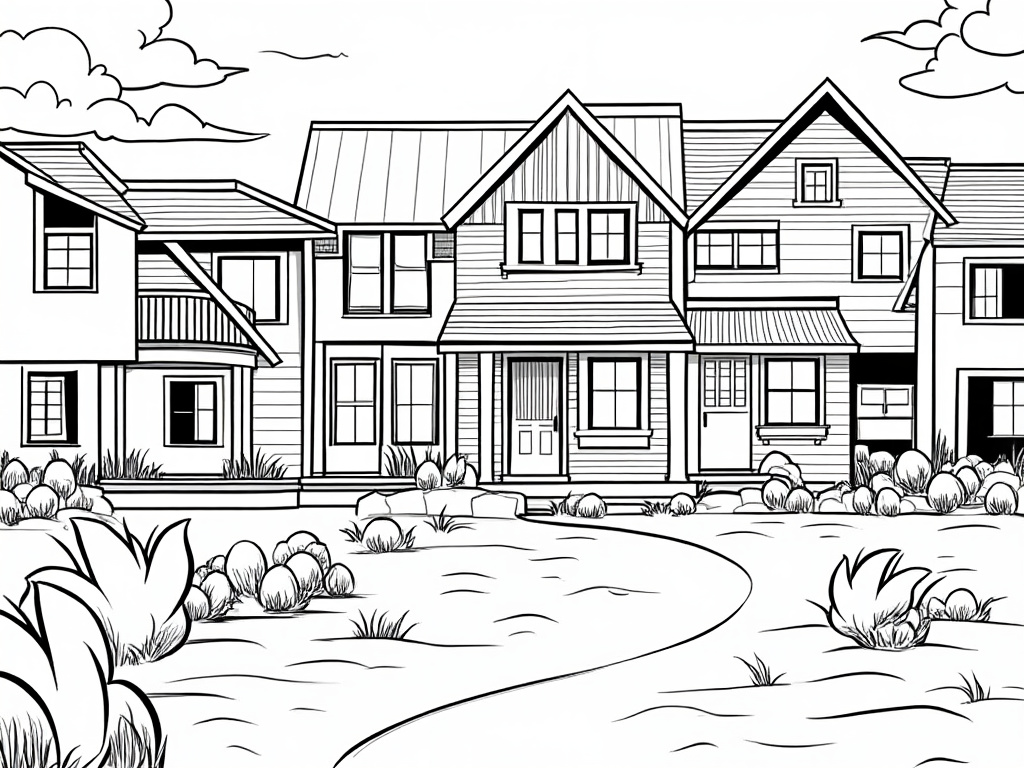
Property Investment Showdown: Personal Use vs. Rental Income Strategy
Reading time: 12 minutes
Table of Contents
- Introduction: Two Paths to Property Ownership
- Financial Fundamentals: The Numbers Behind Your Decision
- Tax Implications: Where Personal and Investment Properties Diverge
- Growth Potential: Assessing Long-Term Value
- Lifestyle Considerations: Beyond the Balance Sheet
- Real-World Scenarios: Property Strategy in Action
- Hybrid Approaches: Getting the Best of Both Worlds
- Your Property Decision Framework
- Frequently Asked Questions
Introduction: Two Paths to Property Ownership
Standing at the property crossroads? You’re facing one of the most consequential financial decisions of your life: should you purchase property primarily for your own use and enjoyment, or should you approach it as an income-generating investment?
This isn’t merely about having a place to call home versus collecting rent checks. It’s about fundamentally different approaches to wealth building, lifestyle design, and financial risk management.
Let’s be clear: there’s no universally “correct” choice. The optimal strategy depends on your financial situation, life stage, personal values, and long-term objectives. What works brilliantly for your colleague might be entirely wrong for you.
Here’s the reality check: property ownership involves substantial capital commitment regardless of your intended use. The average home purchase consumes 5-7 times the buyer’s annual income—making this decision worthy of careful, strategic consideration.
“The difference between buying for personal use versus rental income isn’t just about who lives in the property—it fundamentally changes how you evaluate opportunities, manage finances, and measure success.” — Sarah Chen, Real Estate Investment Strategist
Throughout this guide, we’ll dismantle the complexities of both approaches, equipping you with the insights to make a decision aligned with your unique circumstances and goals.
Financial Fundamentals: The Numbers Behind Your Decision
Before diving into specific strategies, let’s establish the core financial mechanics that differentiate personal-use properties from rental investments.
Cash Flow Dynamics
When you purchase a home for personal use, you’re essentially creating a cash outflow asset. Your mortgage, property taxes, insurance, maintenance, and utilities represent expenses that support your lifestyle rather than generate income.
Conversely, rental properties operate under a fundamentally different financial model. When properly structured, they create regular cash inflows that can exceed your ownership costs, potentially creating positive monthly cash flow.
Consider this key distinction: Your personal residence’s “return” comes primarily through eventual appreciation and the intrinsic value of having a place to live. A rental property’s return is multifaceted—combining ongoing income, appreciation, tax advantages, and potential leverage benefits.
Initial Investment Requirements
The entry costs for these two property paths often differ significantly:
- Primary Residence: Typically requires 3-20% down payment, with the best financing terms and lowest interest rates available
- Investment Property: Usually demands 20-25% down payment, higher interest rates (typically 0.5-0.75% higher), and more stringent qualification requirements
Let’s put this in perspective with a $400,000 property:
| Requirement | Primary Residence | Investment Property | Difference |
|---|---|---|---|
| Minimum Down Payment | $12,000 (3%) | $80,000 (20%) | $68,000 more for investment |
| Interest Rate | 6.5% | 7.25% | 0.75% higher for investment |
| Monthly Payment (30yr) | $2,529 | $2,321 | $208 less for investment* |
| Income Requirement | $75,870 annually | $69,630 annually | $6,240 less for investment** |
| Cash Reserves Required | 2-6 months | 6+ months | Additional reserves for investment |
*Lower payment due to larger down payment despite higher rate
**Based on 40% debt-to-income ratio without considering rental income
Financing Availability
The financial system actively encourages homeownership through programs like FHA loans (3.5% down), VA loans (0% down for eligible veterans), and USDA loans (0% down in qualifying rural areas). These favorable terms significantly reduce the barrier to entry for personal residences.
For investment properties, you’ll generally need stronger credit scores, more substantial cash reserves, and you won’t qualify for many first-time homebuyer programs. However, lenders may consider potential rental income when qualifying you—typically at 75% of market rates to account for vacancies.
Let’s be pragmatic: If your available capital is limited, purchasing a primary residence first often makes financial sense, as it requires less initial investment. Later, you might leverage equity from your home to purchase investment properties.
Tax Implications: Where Personal and Investment Properties Diverge
The tax treatment of residential real estate varies dramatically based on its intended use, creating one of the most compelling differentiators between these property strategies.
Deduction Differences
With a personal residence, tax benefits exist but are relatively limited. The 2017 Tax Cuts and Jobs Act capped mortgage interest deductions at loans of $750,000 and limited state and local tax deductions (including property taxes) to $10,000 annually. Moreover, you’ll need to itemize deductions rather than taking the standard deduction to receive these benefits.
Rental properties, however, open the door to significant tax advantages:
- Deductible mortgage interest (not subject to the same limitations as primary residences)
- Deductible property taxes (not subject to the $10,000 SALT cap)
- Depreciation deductions (spreading the cost of the building over 27.5 years)
- Operating expense deductions (maintenance, insurance, management fees, etc.)
- Travel expenses related to property management
- Professional service fees (accounting, legal, property management)
These deductions can create paper losses even when your property generates positive cash flow—a phenomenon known as “phantom income” that can significantly reduce your tax liability.
“Depreciation is perhaps the most powerful tax advantage of rental property ownership. It allows you to deduct approximately 3.636% of your property’s building value annually against your rental income, potentially sheltering thousands in rental profits from taxation.” — Marcus Johnson, CPA and Real Estate Tax Specialist
Capital Gains Treatment
When selling your properties, the tax implications again diverge dramatically:
- Primary Residence: The Section 121 exclusion allows single filers to exclude up to $250,000 in capital gains (or $500,000 for married couples) if you’ve lived in the home for at least 2 of the last 5 years
- Investment Property: All gains are typically taxable, though you can defer taxes through a 1031 exchange by reinvesting proceeds into another like-kind investment property
This distinction creates interesting strategic possibilities. For instance, you might live in a property as your primary residence for two years, then convert it to a rental—potentially benefiting from both sets of tax advantages over time.
Growth Potential: Assessing Long-Term Value
Both property strategies can build wealth, but they do so through fundamentally different mechanisms with varying growth patterns and risk profiles.
Appreciation Dynamics
While both property types can appreciate in value, the factors driving that appreciation and how you capitalize on it differ:
With a personal residence, appreciation directly increases your net worth, but it remains largely illiquid until you sell or borrow against the equity. The median home price in the U.S. has appreciated at approximately 4% annually over the past 30 years (though with significant regional variations).
For rental properties, appreciation combines with several other value-creation mechanisms:
- Rental income typically increases over time (averaging 3-5% annual growth historically)
- Mortgage principal reduction occurs as tenants effectively pay down your loan
- Forced appreciation is possible through strategic improvements and optimized management
This multi-dimensional growth potential explains why many real estate investors achieve returns that significantly outpace average home appreciation rates alone.
Comparative 10-Year Growth Potential
Based on $400,000 property with 20% down payment
42% Total Return
97% Total Return
127% Total Return
Returns include appreciation, equity buildup, cash flow, and tax benefits. Value-add scenario assumes strategic improvements that increase property value and rental income above market rates.
Risk Profiles
The financial risks associated with these property strategies differ substantially:
Primary residences typically present lower financial volatility, as your housing need remains constant regardless of market conditions. Even during market downturns, you’re still receiving the fundamental benefit of having a place to live.
Rental properties introduce additional risk factors: tenant vacancies, property damage, management challenges, and regulatory changes. However, they also provide more flexibility to adapt to changing market conditions through adjusting rental rates, refinancing, or selling when optimal.
The key insight: Personal residences are primarily consumption assets with investment characteristics, while rental properties are primarily investment assets. This fundamental difference shapes how they perform across market cycles and economic conditions.
Lifestyle Considerations: Beyond the Balance Sheet
Property decisions are never purely financial. The lifestyle implications of these strategies play a crucial role in determining which path aligns with your broader life goals.
Time and Energy Investment
Personal residences typically demand emotional investment but limited ongoing time commitment beyond normal home maintenance (which you’d handle regardless of ownership status).
Rental properties require a more significant time investment for:
- Tenant screening, selection, and management
- Property maintenance coordination
- Financial administration and tax documentation
- Strategic decision-making regarding improvements and rental rates
- Staying informed about local rental regulations and market conditions
While property management companies can handle many of these responsibilities (typically for 8-12% of gross rent), that convenience reduces your cash flow and requires you to manage the management company itself.
Freedom and Flexibility
The freedom implications of these strategies often surprise first-time investors:
Owning a primary residence can actually constrain flexibility—you’re tied to a specific location, responsible for all maintenance, and your equity is locked in the property. Selling typically takes 30-90 days plus closing time.
Rental properties, while demanding more active management, can paradoxically create more lifestyle freedom:
- Cash flow can support lifestyle choices or accelerate financial independence
- Management can be delegated (though at a cost)
- You maintain geographic mobility without selling
- The property can be converted to personal use if circumstances change
The key insight: Align your property strategy with your desired lifestyle trajectory. If career flexibility and geographic mobility are priorities, rental property ownership with professional management might better serve your goals than being tied to a primary residence in a specific location.
Real-World Scenarios: Property Strategy in Action
Let’s explore how these strategies play out through two contrasting real-world scenarios.
Case Study 1: The Urban Professional
Mia, a 32-year-old marketing executive in Chicago, purchased a $425,000 condominium as her primary residence with 10% down. Her decision prioritized:
- A central location that eliminated her commute
- Building equity instead of “throwing away money on rent”
- Personal customization of her living space
- Long-term appreciation in a desirable neighborhood
After five years, her property had appreciated to $495,000 (3.1% annually), building approximately $140,000 in equity through appreciation and mortgage principal reduction. While the financial return was modest, Mia valued the stability, community connections, and personal satisfaction her home provided.
She found that homeownership anchored her in positive ways—encouraging longer-term career planning and providing a sense of achievement. The property became more than an investment; it became central to her identity and lifestyle.
“I could probably have earned more investing elsewhere,” Mia explains, “but my condo gives me something no stock portfolio can—a place that truly feels like mine, in exactly the location I want to be.”
Case Study 2: The Strategic Investor
James, a 35-year-old software developer, took a different approach. Rather than buying in the expensive coastal city where he works, he:
- Continued renting a modest apartment near his office
- Purchased two $180,000 single-family homes in growing Midwestern markets
- Placed 20% down on each property and hired professional management
- Selected properties with positive cash flow from day one
Five years later, his properties had appreciated to $225,000 each (4.6% annually) while generating approximately $300 monthly positive cash flow per property after all expenses. Combined with tax advantages from depreciation, his effective return on investment exceeded 15% annually.
Beyond the financial benefits, James valued the psychological advantage of separating his housing from his investment strategy: “When I’m evaluating where to live, I can make pure lifestyle choices. When I’m evaluating rental properties, I can make pure investment decisions. Not mixing the two has created clarity in both areas.”
The key insight from these contrasting approaches? Your property strategy should align with both your financial goals and your personal values. Neither approach is inherently superior—they simply optimize for different priorities.
Hybrid Approaches: Getting the Best of Both Worlds
The personal-use versus rental property decision isn’t always binary. Several hybrid strategies can capture advantages from both approaches.
House Hacking: Entry-Level Hybrid
House hacking involves purchasing a multi-unit property (duplex, triplex, or fourplex), living in one unit, and renting out the others. This approach:
- Qualifies for residential financing terms (lower down payment, better interest rates)
- Creates rental income to offset or eliminate your housing expense
- Enables hands-on landlording experience with minimal commuting
- Positions you for the primary residence capital gains exclusion on your portion
Consider Marcus, who purchased a $350,000 duplex with an FHA loan (3.5% down). He lives in one unit and rents the other for $1,400 monthly. This rental income covers 75% of his mortgage payment, dramatically reducing his housing cost while building equity and gaining landlording experience.
“House hacking fundamentally changed my financial trajectory. By reducing my housing expense by 75%, I was able to accelerate my savings rate and purchase additional investment properties years ahead of schedule.” — Taylor Reynolds, Real Estate Investor
The Live-In Flip Strategy
Another hybrid approach involves purchasing a primary residence in need of renovation, improving it while living there, and either selling for a tax-advantaged profit or converting it to a rental property.
This strategy leverages:
- Favorable primary residence financing
- Sweat equity to force appreciation
- Tax-free capital gains (up to $250,000/$500,000)
- The option to rinse and repeat every two years
The key insight: By creatively combining elements of both strategies, you can often overcome the limitations of each individual approach while capturing multiple benefits simultaneously.
Your Property Decision Framework
Rather than prescribing a one-size-fits-all recommendation, let’s build a decision framework to help you determine which property strategy best aligns with your unique situation.
Five Critical Assessment Factors
Evaluate your circumstances against these five key dimensions:
- Financial Stability: Do you have stable income, adequate emergency reserves, and the capacity to handle unexpected property expenses? Primary residences typically require more financial stability due to less flexibility.
- Time Horizon: How long do you anticipate holding the property? Longer horizons generally favor investment properties due to compounding benefits of appreciation, rent increases, and loan amortization.
- Geographic Commitment: How certain are you about remaining in your current location? Less certainty favors rental investments over primary residences.
- Active vs. Passive Preference: Do you want direct involvement in property management, or would you prefer a more hands-off approach? Your temperament for landlording matters significantly.
- Portfolio Balance: How does real estate fit within your broader investment strategy? Consider correlation with your existing assets and overall diversification.
Action Steps: Implementing Your Strategy
Once you’ve clarified your direction, take these concrete next steps:
- Financial Preparation: Strengthen your credit score, organize documentation of income and assets, and save for your down payment and reserves
- Market Research: Analyze local market trends, including price-to-rent ratios, appreciation patterns, and neighborhood development plans
- Team Building: Assemble professional support—realtor, mortgage broker, property inspector, and potentially property manager
- Scenario Testing: Run financial projections for multiple properties under both optimistic and pessimistic conditions
- Decision Timeline: Create a structured timeline for your property acquisition, including specific milestones and flexibility for market conditions
Remember: Your first property decision isn’t your last. Many successful real estate investors begin with a primary residence, build equity and experience, then gradually transition toward investment properties as their financial capacity and knowledge expand.
Beyond Binary Thinking: Your Strategic Property Path
The property landscape offers far more nuance than the simple personal-use versus rental income dichotomy suggests. The most successful property owners often evolve their strategy over time, adapting to changing market conditions, personal circumstances, and financial opportunities.
Rather than viewing your property decision as a permanent commitment to one approach, consider it the first step in an evolving portfolio strategy. The skills, equity, and knowledge you develop through your initial property—whether personal or investment—create the foundation for expanded opportunities.
Remember these essential principles as you move forward:
- Both approaches can build wealth when executed with diligence and patience
- The “right” strategy is the one aligned with your unique financial situation, temperament, and goals
- Hybrid approaches can offer creative solutions to overcome traditional limitations
- Your property strategy should evolve as your life circumstances and financial capacity change
- The most valuable property is one that advances your personal definition of success
What property path will you pioneer? Whether you prioritize creating your ideal living environment or building passive income streams, the key is making a conscious, strategic choice rather than drifting into either approach without clear intention.
Is it time to transform your property aspirations into concrete action? Your future self—whether relaxing in your dream home or reviewing your rental property portfolio—will thank you for the strategic foundation you’re building today.
Frequently Asked Questions
Can I convert my primary residence to a rental property later?
Yes, and this “live-then-rent” strategy offers several advantages. By purchasing as a primary residence, you benefit from lower down payments and better interest rates. After living in the property for at least a year (to satisfy mortgage requirements), you can convert it to a rental. This approach allows you to gain homeownership experience before becoming a landlord and can create a natural progression into real estate investing. Remember to notify your insurance company and mortgage lender about the change in use, and consult a tax professional about depreciation recapture and other tax implications.
How does leverage differ between personal residences and investment properties?
Leverage works differently across these property types in several key ways. Primary residences typically allow higher leverage (up to 97% with some loan programs) while investment properties generally require at least 20-25% down payment. However, investment properties create a unique form of leverage—your tenants effectively pay down your mortgage principal while you maintain control of an appreciating asset. This creates what many investors call “good debt”—borrowing that potentially generates more value than its cost. Personal residences offer leverage on a consumption asset, while rental properties offer leverage on an income-producing asset—a distinction that dramatically affects long-term financial outcomes.
What exit strategies are available for each property type?
Your exit options vary significantly between property types. With a primary residence, you typically have two main exits: selling (potentially with capital gains exclusion) or remaining indefinitely. Investment properties offer more flexible exit strategies: selling for profit, executing a 1031 tax-deferred exchange into another investment property, refinancing to extract equity while maintaining ownership, converting to a primary residence, or holding for generational wealth transfer with significant estate tax advantages. This exit flexibility represents one of the less-discussed but significant advantages of investment properties—they can be adapted to changing market conditions and personal circumstances more readily than primary residences.




